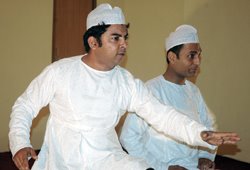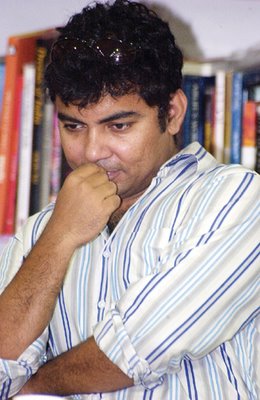

| THE REAL PAGE 3 | |
| Yarn spinner | ||
| Spinning a fantasy no less magical than the Arabian Nights gives Delhite Danish Husain much to do | ||
| Shirin Abbas | ||
| Lucknow, September 30: Chubby cheeked and cherubic, D(a)anish Husain looks as sweet and tempting as the Danish pastries his name is often mispronounced as. His foray into the art form was accidental, but about a dozen sessions of Dastan Goi later, this former corporate banker, now full-time theatre guy, has made it his mission to revive the art form and build a global audience for Dastan Goi. "It was in March this year that I was approached by Mahmood Faroqui who had originally started Dastan Goi with friend Himanshu Tyagi and was on the look out for a partner. We had only twelve-odd days to prepare as the performance was on March 27. It was a very challenging art form and a dozen-odd shows later, I am so glad I took up the task," says Husain. Another plus is the lack of any moralistic stands in the script. "The story is pure entertainment. Apart from the basic premise that Amir Hamza is the good man, the Prophet's uncle out to destroy the charlatan Afrasiyaab, which exempted them from Islamic decrees, there is ample leverage for the main characters to indulge in all sorts of vices- wine, women, makkari, ayyari, magic, fantasy- hence, its appeal." Language too becomes redundant faced with the perfect mimicry that accompanies the art. Husain talks of an American guest at a Mumbai performance who said he understood the entire story without knowing a word of Urdu. "Yes, it is Urdu at its literary best, with more than a fair sprinkling of Faarsi, but the stories have eloquence and a cadence that appeals to all irrespective of whether or not they understand Urdu. The language, the rhythm, the juxtaposition of ideas, metaphors and words bind you," he explains.
"Everything that you start is accompanied by hurdles. It's never a smooth walk initially. More so with people ready to give a communal flavour to the language, an administration apathetic to the cause and educational system that doesn't give you anything by way of an education. But it is heartening to note that despite all this, the response from the general public is always heartening. I think people are aware of their social and cultural responsibility and the need to protect and preserve these dying art forms is propelling them to get back to their roots and make this one bid to preserve their heritage. After the play in Mumbai I met a few young boys- in jeans cargos, tees- like your average metro teenagers and they asked me where and how they could learn Urdu. It made me feel so good about what I was doing."
| ||
| |

No comments:
Post a Comment